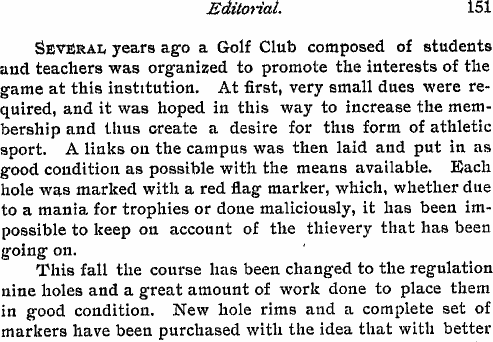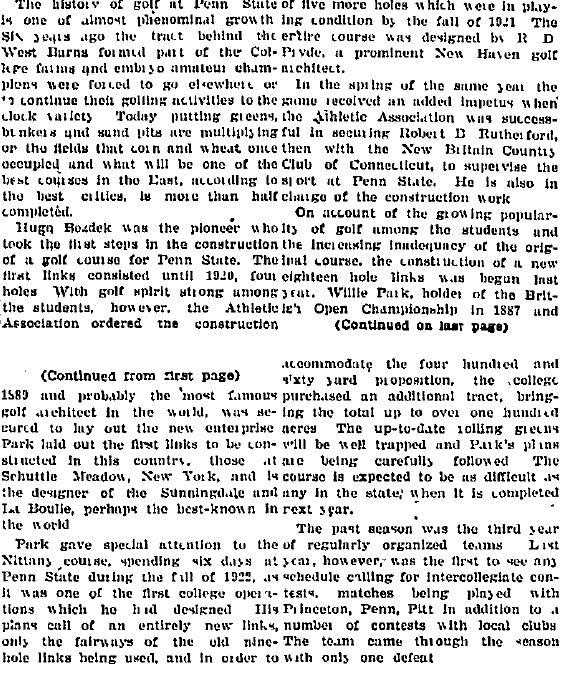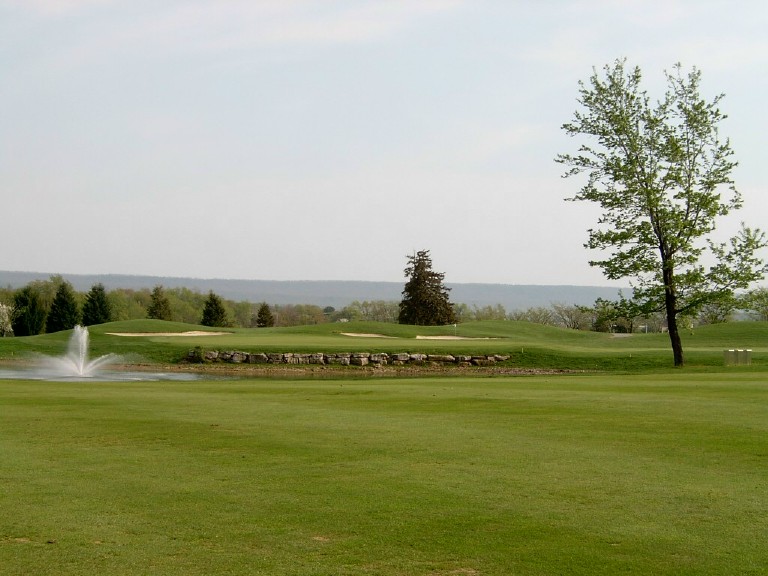Penn State University Golf
by
Kyle Harris
January, 2011
Golf at Penn State is almost an afterthought. The golf season and school year for the most part do not overlap; with snow cover being possible anytime between November and April, most of the students get two or three months at most with which to play golf. It would probably come as no surprise to not find any worthwhile golf experience in State College, PA, however, the Penn State Golf Courses are filled with relevance spreading across over ninety years of golf architecture history.
To date, the earliest known record of golf at Penn State comes from a December 1, 1901 article in the student-run organ Free Lance. Of note is the mention in the article that Penn State students and faculty played golf around the campus for several years at the time and that the intramural club recently completed laying out nine holes complete with new hole tins. Superintendents may delight to read that the article also laments the swiping of the red flags used to mark the holes by students as pranks.
Harrison & Garbin were both golf architects of the Donald Ross lineage and both were Penn State alumni whose work focused primarily in Western Pennsylvania, making them ideal candidates for the new course. The course played across more rugged and wooded terrain than the White Course and the routing did much to take advantage of these features. Reflecting the style at the time, the greens were bigger and generally flatter with sparse but effective bunker placement.
Notable holes on the layout included the long second and third holes of 540 and 460 yards respectively playing over the most severe portion of the property and requiring the golfer to maneuver across reverse camber doglegs. The stretch of holes starting at the twelfth through the finish challenges the golfer’s distance ability and decision making. The twelfth tee shot forced a particularly vexing decision. Players teed off to a fairway bending to the right and down into a stand of woods. The player could play to the top of the hill leaving an approach no shorter than 180 yards to a well bunkered green placed across the valley. The second option compelled the player to flirt with the right edge of the tree line and allow the ball to bound to the bottom of the valley leaving a short pitch to the green above. Shots played too far and left would be kicked into the trees left while shots not reaching the ridge right would be slightly blocked by the overhanging limbs from the trees right.
Perhaps the only true criticism of the layout is found in the lack of short hole variety as the quartet all played within the 170-200 yard range. However, it is important to note that the routing allowed for all four to play in different directions, as well as featuring a downhill, uphill and two oppositely sidehill holes.
Research has yielded little about this early layout so far. However, a December 10, 1908 article in the Daily Collegian (which supplanted the Free Lance as the College’s student newspaper in 1904) reported the golf course lasted four to five years before being seized for College expansion and the student body had been lobbying for a reinstatement of the golf course ever since.
In January 1919, the College dedicated itself to a comprehensive athletic plant and program with athletic facilities including a new nine hole golf course on the western edge of campus situated near a new gymnasium (Recreation Hall) and football stadium. Contemporary Daily Collegian articles credit athletic director Hugo Bezdek, who also managed the Pittsburgh Pirates at the time, with the vision for the entire athletic program. Bezdek hired New England-based R. D. Pryde to lay out the nine hole golf course. The Daily Collegian reports that Pryde completed five of the holes within the year and soon completed the remaining four holes in 1920. At this time, Bezdek hired New Britain Country Club (Connecticut) golf professional Robert D. “Pop†Rutherford to supervise the sport’s development and growth at Penn State.
Rutherford organized the golf teams and began competition with local Country Clubs and other Universities. Rutherford also served as golf professional and greenkeeper. Popularity in the sport grew under Rutherford’s leadership and by 1922, the golf facilities at Penn State underwent their most significant upgrade and expansion to date under none other than Scottish golf professional and architect Willie Park, Jr.
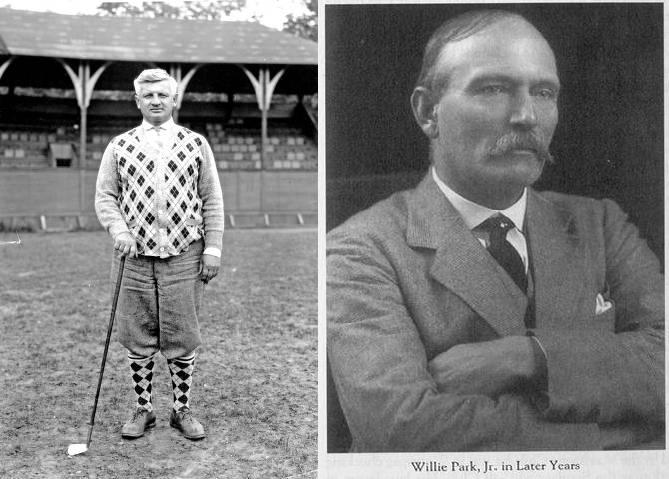
Hugo Bezdek and Willie Park, Jr. (Courtesy of Penn State Digital Photo Archives and John Adams, The Parks of Musselburgh)
Willie Park, Jr. at Penn State
Daily Collegian reported that Willie Park, Jr. spent six days on-site in State College during the Fall of 1922. Park’s plans upgraded the current nine holes and added a second nine. Daily Collegian noted that Park “gave special attention to the nittany course†and that this project was the “first college operation he had designed.†Park’s work would include all new bunkers and greens while using the original fairway corridors. The University is currently in possession of a copy of the full 18 hole routing, complete with distances as drawn by Willie Park, and this can be found displayed prominently in the front of the Penn State Golf Courses Clubhouse.
This article also reports that the College acquired land further west of the original course to accommodate a newly designed 460 yard hole. Further details from contemporary Daily Collegian articles note that Park’s finished lay out extended to over 6400 yards and that play on the original nine holes would not be interrupted while construction of the new nine commenced. A notable line from this article states that the course would be “of official championship length and without a doubt the best course maintained by any college in the country,†showing that even in 1922, new development in golf stood prone to sometimes bold claims.
Willie Park historians may note this time frame as the beginning of the intrepid architect’s slow decline into poor health. The trip to remote State College, PA required an over five hour train ride from New York City or four hour train ride from Philadelphia to Altoona, PA along the Pennsylvania Railroad mainline and then another hour long trip by train into State College. When placed in the context of Park’s other contemporaneous projects at Philmont Country Club, Ashbourne Country Club and Green Valley Country Club in the Philadelphia area it is easy to see how Park’s health was at risk due to over work.
Work on the golf course commenced in October 1922 under the direction of “Pop†Rutherford as superintendent. To date, it is uncertain as to the reason why golf course construction lasted into 1924 where a Daily Collegian bulletin announced temporary greens would be open on the newly constructed holes but warned that play would not be permitted on the new putting surfaces until the seed had established. The Daily Collegian also proudly announced that a freshman golfer had established the course record of 67 in May 1928.
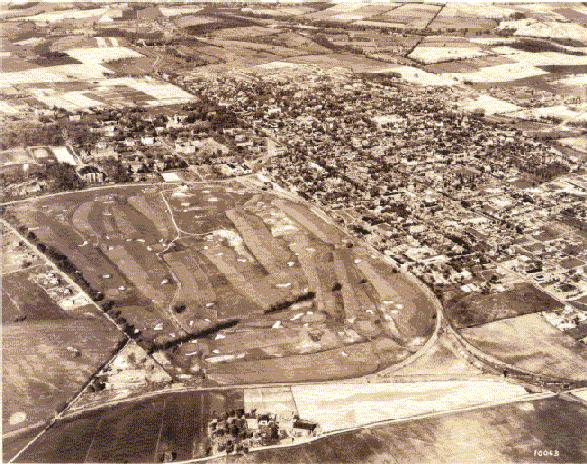
The Golf Course in 1938 – First/Tenth Green in Upper Right Corner (Courtesy: PennPilot Digital Archive)
The golf course remained unchanged with the exception of the relocation of one green due to the construction of a new railroad freight facility in 1940. This change is seen in comparing the aerial photograph from 1938 and 1971. The original hole was likely a typical Willie Park short hole, similar to the type found at Glen Ridge Country Club’s second hole or Schuylkill Country Club’s sixteenth hole. Also of interest is the addition of another short hole near the 1st green. This hole is not seen in the Willie Park routing but is present in diagrams of the course as early as 1938. Perhaps the hole was designed to facilitate two tee starts or the reversal of the nines (the original first tee was located very near the right-of-way for Atherton Street – present day U.S. Business Route 322) but the actual origin and purpose for the hole is not known as of this writing.
The University Era
Penn State’s remarkable growth following World War II under the direction of Milton Eisenhower granted the College University status by 1953 This growth coincided with a rejuvenation of the athletic program following the reinstatement of athletic scholarships in the 1940s (Notably, football assistant coach Joe Paterno joined the staff with head coach Rip Engle in 1950). Demand for golf increased to the point that the University began considering a second eighteen hole course in the late 1950s and this finally came to approval in 1964, as reported in The Daily Collegian.
The firm of Ferdinand Garbin and James Harrison designed the new “Blue†Course to complement Willie Park’s “White†Course. The Blue Course opened in 1969 on property adjacent to the White Course and played just over 7000 yards. A new clubhouse and practice facility was constructed along a driveway connecting to West College Avenue a mile from the campus to accommodate the new course while the White Course continued to operate out of the Pro Shop located behind Recreation Hall.
The Blue Course Opens
Harrison & Garbin were both golf architects of the Donald Ross lineage and both were Penn State alumni whose work focused primarily in Western Pennsylvania, making them ideal candidates for the new course. The course played across more rugged and wooded terrain than the White Course and the routing did much to take advantage of these features. Reflecting the style at the time, the greens were bigger and generally flatter with sparse but effective bunker placement.
Notable holes on the layout included the long second and third holes of 540 and 460 yards respectively playing over the most severe portion of the property and requiring the golfer to maneuver across reverse camber doglegs. The stretch of holes starting at the twelfth through the finish challenges the golfer’s distance ability and decision making. The twelfth tee shot forced a particularly vexing decision. Players teed off to a fairway bending to the right and down into a stand of woods. The player could play to the top of the hill leaving an approach no shorter than 180 yards to a well bunkered green placed across the valley. The second option compelled the player to flirt with the right edge of the tree line and allow the ball to bound to the bottom of the valley leaving a short pitch to the green above. Shots played too far and left would be kicked into the trees left while shots not reaching the ridge right would be slightly blocked by the overhanging limbs from the trees right.
Perhaps the only true criticism of the layout is found in the lack of short hole variety as the quartet all played within the 170-200 yard range. However, it is important to note that the routing allowed for all four to play in different directions, as well as featuring a downhill, uphill and two oppositely sidehill holes.
Consolidation and Modernization: 1994-2010
The golf courses remained largely unchanged through the next two decades. By the early 1990s, the University began an era of unparalleled expansion linked to joining the Big Ten and a desire for a larger academic plant. The available land forced new construction across Atherton Street into the traditional athletic fields, including the golf course. With land available along the entrance drive for the Blue Course, plans were made to begin running a 36 hole facility from this location while yielding land from the White Course for new academic buildings. The golf architecture firm of Ault, Clark and Associates were retained to sort through the planning and implementation of linking both courses to run from the West College Avenue location.
The initial plan implemented gave over the tenth and eighteenth holes of the White Course to the displaced Rugby and Soccer fields, retained much of the first nine of the Blue Course to serve as the beginning and finishing holes for the White Course (thus linking the Willie Park holes to the new clubhouse), set aside six holes from the White Course as a practice course and finally, constructed a completely new second nine for the Blue Course on the property just south of the older nine along with two new holes for the White Course to make up for the lost tenth and eighteenth. The second nine for the Blue became the first nine.
Oddly, this arrangement gives both courses several different stylistic approaches contained wholly within a single round. The two distinct nines of the Blue Course are good examples of their respective architectural eras, while the White Course—with the middle stretch containing the Willie Park holes—has a museum-like quality showcasing different eras in different contexts of the round.
Again, in 2003, the golf courses initiated a master plan. The goal was to host the Big Ten Championship on the Blue Course and upgrade the White Course with a nod to its lineage. David Heatwole, a former Jack Nicklaus associate and current, independent golf architect in State College, PA, reworked the seventh and eighth holes into a more appropriate test of golfing mettle. While the seventh hole stood as a fine one-shotter, a heightening tree line and increased technology victimized the awkward ninety-degree-dogleg eighth. Heatwole relocated the seventh green into the landing zone of the eighth, creating a 440 yard proposition that required—perhaps on purpose, considering the lineage—two high faded shots to achieve the hole in regulation. The new eighth tee replicates the original uphill approach shot of the old eighth hole. This latest change further adds to the architectural diversity of the Penn State facility.
The 2003 master plan also ushered in an era of White Course revitalization that stretched the course to over 6300 yards by rebuilding and relocating several tees. Further tree removal, fairway and green expansion further restored the remaining 1922 holes as intended by Willie Park and this work continues to this day under the careful eye of Superintendent Rick Pagett.
The Penn State Golf Courses offer thirty-six holes of worthy architectural study. When coupled with exploring nearby Toftrees Resort, Alex Findlay’s Centre Hills Country Club and the State College Elks, State College is a unique golf destination that provides a suitable golf experience for all golfers.
First Hole – 372 Yards
Harrison & Garbin “ 1970
The opener is a straightforward Par 4 of 370 yards. A tee shot favoring the left side of the fairway will leave an approach to an elevated and well-guarded green. The green is large and slopes from back right to front left. Finding any of the bunkers surrounding the green leaves a tricky, but straightforward up and down.
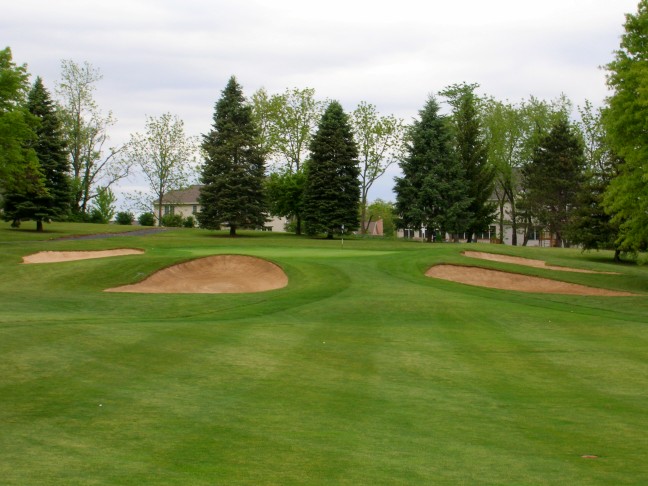
The heavily bunkered opening green from the left side of the fairway.
Second Hole – 370 Yards
Harrison & Garbin “ 1970
Ault & Clark “ 1994
The second hole is probably the best of the non-Willie Park holes on the White Course. After a walk across the back tee of the driving range, the golfer is presented with his first real challenge of the round. The tee shot must be faded or aimed at the fairway bunker with a draw to stay in the fairway. The bunker short of the green seems to be right next to the green from the fairway, however, it sits 25 yards short of the front edge. On windy days, the preferred approach is low and running around this bunker to the green, which is the flattest on the course.
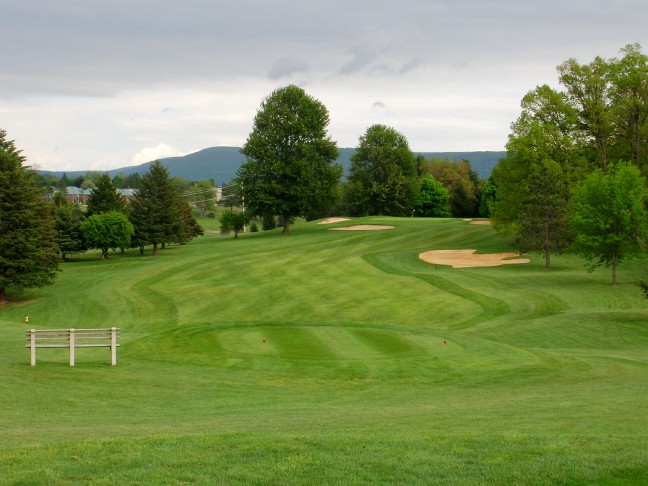
A well executed tee shot near the fairway bunker should leave a straightfoward, but semi-blind approach.
Third Hole – 526 Yards
Harrison & Garbin “ 1970
Ault & Clark “ 1994
After walking across the 18th hole to get to three (and noting the hole location on the 18th green) the par five third lies before the golfer. A well struck tee shot will still leave the golfer short of the crest of the hill. As early as two years ago the fairway was split by a band of rough around 250 yards from the green, making the golfer potentially think about his choice of club off the tee. Now, the fairway is cut all the way through, allowing plenty of room to let it fly. Attempts to reach this green in two will be completely blind, unless the hole is in the back portion of the green in which case the top of the flag is visible from the landing area. The green is the most sloped of any of the non-Willie Park holes and two putts are difficult from above the flag.
Fourth Hole – 330 Yards
Harrison & Garbin “ 1970
Ault & Clark “ 1994
This short par four lost some strategic elements in the 1994 renovation. The ideal line off the tee is still toward the fairway bunker, however, there is significantly less room than there was pre-1994 down the left side. A second fairway bunker, which marked the edge of the old fairway has grassed over to the left of the remaining fairway bunker. A shot down the right side of the fairway leaves a tricky approach of a deep bunker to a large, rolling green that is almost four clubs deep.
Fifth Hole – 210 Yards
Harrison & Garbin “ 1970
Mike Ward “ 2005
The first of a quintet of strong par threes on the course, the fifth hole is a 200 yard proposition to a large, but well-bunkered green. Two new tee boxes added in 2005 have shifted the angle of play to the right and have made the right side of the hole slightly blind.
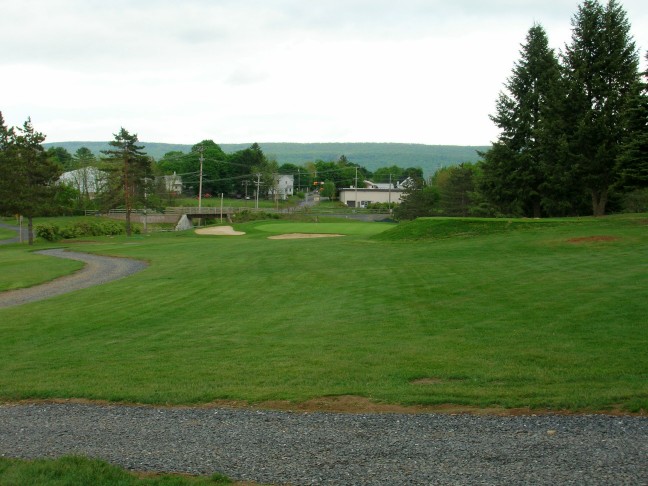
A new tee box leaves a tricky semi-blind tee shot into this fifth green.
Sixth Hole – 440 Yards
Willie Park, Jr. “ 1922
Frank James “ 1949
Ault & Clark “ 1994
Mike Ward “ 2005
The most maligned hole on the golf course features a classic Willie Park green, a large centrally placed bunker complex and a blind approach. The tee shot must reach the upslope of the fairway in line with or slightly left of the bunkers. A blind approach should favor the right side of the hole as any shot landing short of the green will funnel back and to the left side. The first of the Park greens is also one of the most treacherous as any putt above the hole will be hard to stop, especially from the back tier.
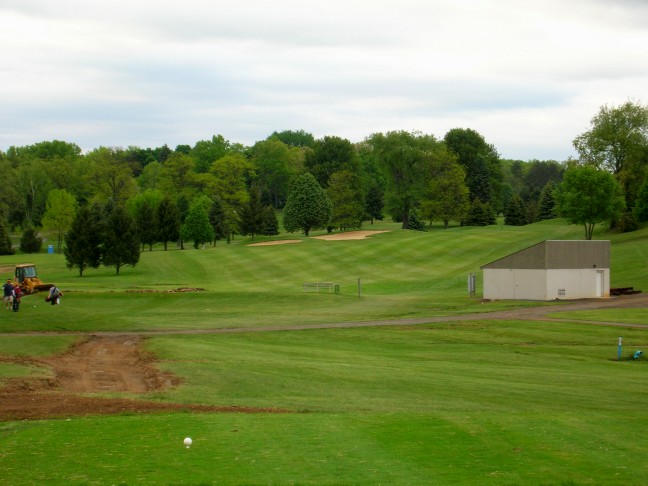
The ideal line off the new tee is at or slightly left of the bunkers. The trees to the left of the hole are slated to be removed by 2007.
Seventh Hole – 176 Yards
Willie Park, Jr. “ 1922
Frank James “ 1949
The uphill 7th Hole has some of the most dramatic bunkering on the course. A mid-iron must find the back half of the green else risk rolling off the significant false front. Finding any of the bunkers is a surefire way to make double bogey, as is missing the green long.

Shots not reaching the flag are liable to run off the extended false front of this horizon green.
Eighth Hole – 350 Yards
Willie Park, Jr. “ 1922
Frank James “ 1949
One of the three complete Park par fours on the course, the 8th hole is a slightly uphill and well bunkered hole. The ideal tee shot challenges the right side fairway bunker to leave a wedge shot into a guarded green tucked amongst deep bunkers and mounds. The green falls away to the left and right in the back portion of the green and shorting siding the green will leave the golfer will almost certain bogey or worse.
Ninth Hole – 356 Yards
Willie Park, Jr. “ 1922
Frank James “ 1949
The 9th hole is gentle downhill hole that invites the golfer to lay into a drive. The ideal drive should end up just short of a fairway bunker that is through the left of the fairway leaving a tricky wedge shot into a very elevated green. Any drive missing left or right will have to contend with two giant hickory trees planted in 1949 under the direction of Frank James, who planted several similar trees and added a few bunkers around the greens.
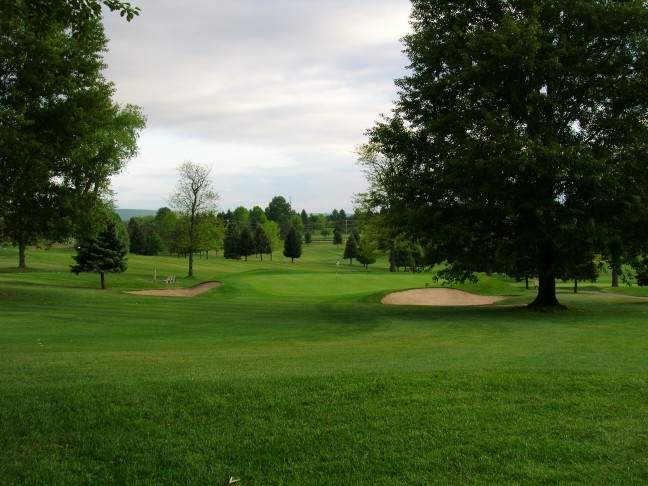
The push up ninth green from the right side of the fairway, showing the trouble a golfer can find with a sliced or pushed drive.
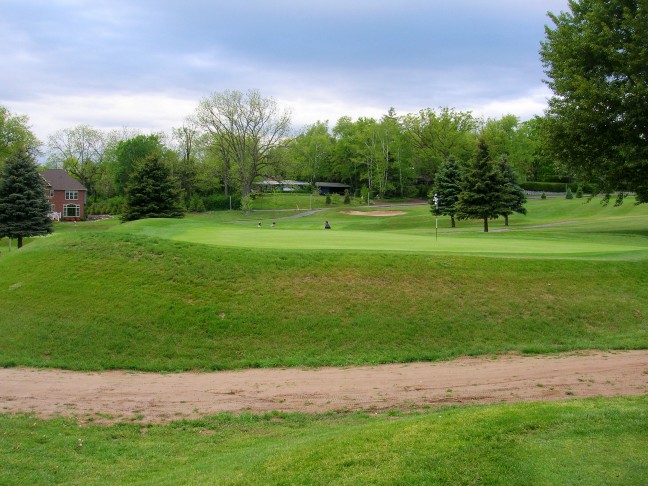
The drastic fall away on three sides of the ninth green is shown in this picture from the left of the green, placing an even larger premium on an accurate approach. The front of the green will kick balls onto the putting surface, however.
Tenth Hole – 462 Yards
Willie Park, Jr. “ 1922
Frank James “ 1949
The second nine of the White starts off with an uphill, short par 5; beginning a stretch of holes where the tournament golfer needs to pick up two strokes to par to compete. A tailwind and a good tee shot will leave the golfer with a long-mid iron approach to the most undulating green on the course. Like most of the Park greens, missing the green will leave a tricky up and down.
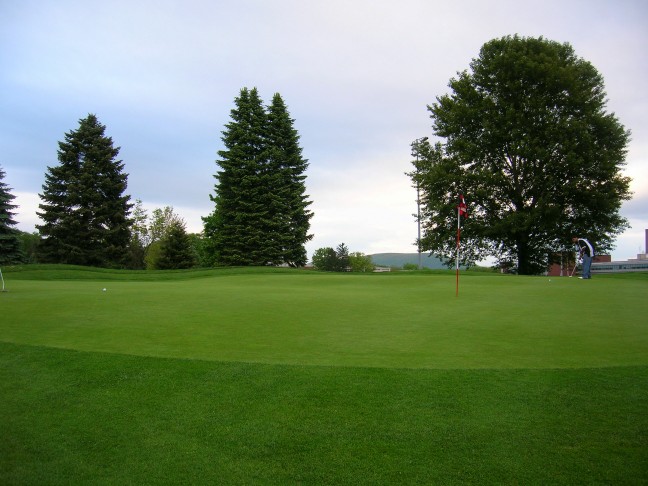
The 10th green is the most undulating on the course witha deep swale running through the middle of the multi-tiered green. Note the back tier and the location of the golfer, a good three feet higher than the hole.
Eleventh Hole – 370 Yards
Willie Park, Jr. “ 1922
Mike Ward – 2005
A much needed new back tee was added to the 11th hole in 2005. Unfortunately, this hole has lost the most through years of tree planting and bunker neglect than any hole on the course. The tee shot sets needs to be shaped from left to right to stay in the fairway, leaving a wedge or short iron to a small green. The center line of the original hole is now the tree line down the right side, and two grassed over bunkers mark the original fairway boundaries.
Twelfth Hole – 170 Yards
Harrison & Garbin “ 1970
Ault & Clark “ 1994
Mike Ward – 2002
A difficult par three set up against Atherton Street (US Bus. Rt. 322) across from Rec Hall. The hole can be categorized as a very gentle Redan, however, the fairway and green do not fall away from the golfer nearly as dramatically as other Redans. A draw will find its way to any flag tucked behind the front bunker if it hits the putting surface though. The site of the original first green is now a practice green to the right of the hole, and the original first tee was located at the intersection 200 yards directly behind the tee box on Atherton Street.

The site of the original first tee box from the 1922 routing is directly behind the sign in the middle of the interesection on Rt. 322!
Thirteenth Hole – 555 Yards
Willie Park, Jr. “ 1922
With the exception of the narrowing of fairways and the green site, this hole is most untouched of the holes on the White Course. The ideal line is just over the left edge of the massive fairway bunker that obscures the view of the hole from the tee. From hear, the golfer is enticed into going for the green, but any short of pulled or hooked shot will find trouble in the form of bunkers and mounding and a poor angle into the green. The more cautious player will lay up to about 140 yards and come at the green with a short iron. The fall away over the back and to the left of the green is the deepest (almost 20 feet!) on the course.
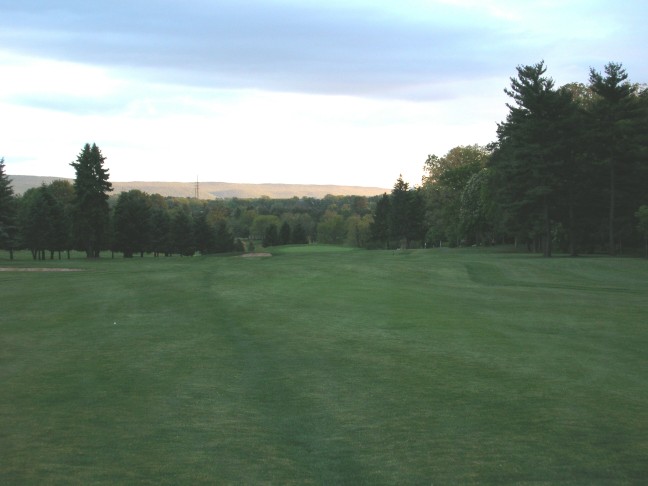
The long thirteenth hole at dusk, showing how much size the greens have lost. The original green stretched out to the edges of the green pad, which drops off twenty feet over the back and left.
Fourteenth Hole – 200 Yards
Willie Park, Jr. “ 1922
Frank James “ 1949
The 14th hole is a superlative downhill par three with the best overall green on the course. The green invites the golfer to land the ball short and funnel the ball to the hole. Missing short leaves an easy chip, where missing long, left or right leaves a difficult pitch to a rolling green.
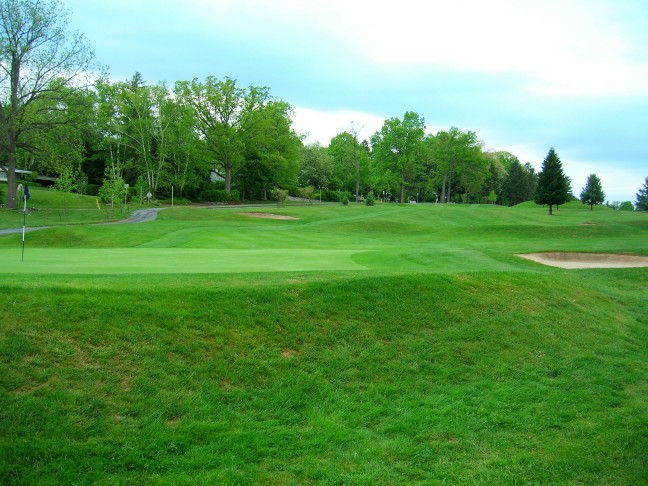
The downhill 14th hole from behind the green, showing the banked fairway and green contours. Missing long is double bogey territory.
Fifteenth Hole – 323 Yards
PSU Golf Team “ 1994
The 15th is a short dogleg right par four that is drivable in a tailwind. The ideal tee shot is just to the left of the bunkers at the corner of the dogleg, where the slope will funnel the ball toward the hole. Depending on the wind and hole location, a high pitch or chip will tuck itself close to the hole. The large, flat green is one of the fastest on the golf course.
Sixteenth Hole – 198 Yards
PSU Golf Team “ 1994
This long downhill par three plays to a narrow green guarded by two shallow bunkers. The tee is the most exposed on the course and the hole can play three clubs shorter or longer depending on the wind. Like the 15th green, this green is large, flat and fast.
Seventeenth Hole – 329 Yards
Ault & Clark “ 1994
This short, sharp dogleg left is drivable with a high draw. The ideal line is over the last tree at the corner of the dogleg, which will leave the golfer with a tricky pitch to an elevated and deep green. Like most holes on the White Course, distance control is paramount on this flat, quick green.
Eighteenth Hole – 510 Yards
Harrison & Garbin “ 1970
Mike Ward “ 2005
This hole was lengthened from a 420 yard par four to its present length in 2005. Interestingly, the original played as the most difficult hole on the course as the golfer was faced with an uphill approach with a mid-long iron to a narrow green guarded in the front by two deep bunkers. The new par five will be opening soon after the time of this writing, and it will be interesting to see how the hole plays out. Tree removal around the green has drastically improved turf conditions and the new tee box should continue the improvements. The hole should be reachable with two great shots and the green complex definitely puts a premium on an approach from way out in the fairway or within 100 yards.

On the new par five 18th hole, going for the green in two is compounded by these fairway bunkers and a narrow, deep green. Golfer laying up will see a premium placed on accuracy as the contours around the green will kick the ball away.
After the round, the first time player of the White Course may be left scratching his head in bemusement over the worth of the course. The beginning and ending stretches are convoluted and piecemeal, but the middle holes provide a challenge worthy of any golfer. In a way, the course blends the older, ‘core golf’ with a more modern ‘individual hole’ aspect “ giving golfers of all tastes and abilities something to wrap their brains and games around. Like most underappreciated golf courses, the White Course takes a little time and effort to fully appreciate, but at that point, it’s an absolute joy and pleasure to play everyday.
The End


